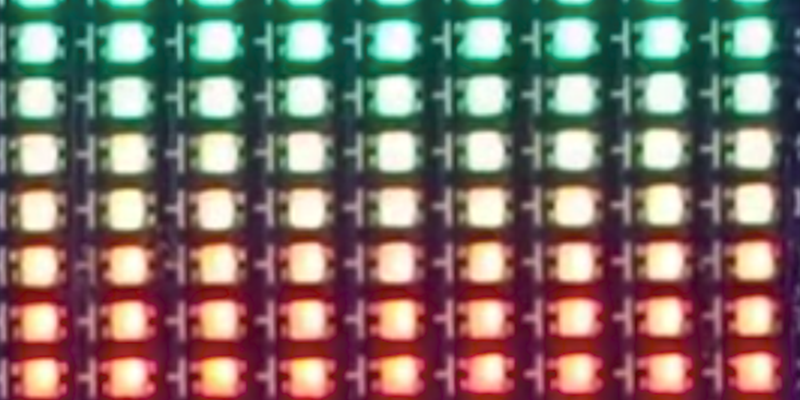It seems that most of the electrical engineering covered on Hackaday concerns exactly one problem domain: how to blink a bunch of LEDs furiously. There are plenty of LED drivers out there, but one of the more interesting in recent memory came from ISSI in the form of a chip that turns I2C into a Charlieplexed LED array. You may have seen this chip — the IS31FL3731 — in the form of an Adafruit LED matrix and some stupid thing some idiot made, but with it you’re only ever going to get 144 LEDs in an array, not enough if you want real blinky bling.
Now ISSI has released a more capable chip that turns I2C into many more Charlieplexed LEDs. The IS31FL3741 will drive up to 351 LEDs in a 39×9 matrix, or if you’re really clever, an 18×18 single color LED matrix.
Features of this chip include reverse/short detection for each individual LED, 8-bit PWM, dimming functions, a de-ghosting feature that guarantees a LED is either on or off, a configurable row/column matrix, and a few other handy tools that you would like to see in a LED matrix driver chip. The most impressive chip in this series will be available for under $2/piece in quantities of 2500, although unlike the IS31FL3731, it appears this new chip will only be available in a QFN package.
Speaking from experience, this is a really great chip for driving a whole boatload of LEDs, provided you have a pick and place machine. Yes, you can hand-solder a QFN and several hundred 0402 LEDs, but I wouldn’t recommend it. I really, really wouldn’t recommend it. That said, this is the perfect chip for maximum blinky bling, and the press material from ISSI gives us the great idea of using one of these chips as the backlight controller for RGB LED mechanical keyboards. That’s a great application, and the chip is pretty cheap, too.
You can check out ISSI’s blinky demo video of this chip below.
















Unless I’m misreading things badly, there’s no charlieplexing in the new (‘3741) part; it appears to be a big 39×9 conventional matrix.
I read it the same way.
You do all realise that Mr Benchoff is discussing *two* ‘new’ parts in this article? (as far as I can tell, HaD is using the term ‘new’ from the perspective of most readers, not their manufacturing age, i.e. new to oneself, not new in creation).
The ‘3731 (the first device to be mentioned which uses charlieplexing) and a, new to being produced, ‘3741 (which may not be as accessible to some as it’s only available in a QFN package).
I’d almost say that it was like people just want to leap to hating Benchoff :-/
I wish I could find a evaluation board for the IS31FL3733, but so far had no luck. :(
Having read the datasheet for the ‘3733, the ‘breath’ function sounds interesting but I now also note that the ‘3731 has something similar (plus it has an ‘audio’ function and an 8-frame store). If anything the new ‘3741 sounds like quite a dull device, as it’s only an LED matrix with no other functions present.
You pronounce LED like “lead” (as in the element), don’t you?
In the UK it is usually ell eee dee
Dat’s how dis Yank pronounces it too!
I’m confused, I have no trouble driving 600+ rgb leds from a couple of dollars worth 8266 board, and with the same board I can drive an 18 by 18 (quoted above) faster than 30 updates a second (so have no trouble with animation). So why do we need a special chip?
Are you driving naked LEDs, or are you driving serially addressable LEDs?
Yeam, hobbyists can just use Neopixels. I guess its mainly for reducing cost for mass-produced products?
If you can drive hundreds of LED with this it would mean it can also drive hundreds of optocouplers though, think about it.
Or maybe IR LED or some such for which it would be hard to find a neopixel equivalent.
Also neopixels are still a lot more pricy than a SMD LED and take way more space.
“It seems that most of the electrical engineering covered on Hackaday concerns exactly one problem domain: how to blink a bunch of LEDs furiously.”
PLEEEEZE do not confuse “Electrical Engineering” with “Maker Stuff”!
I know plenty of makers who can go into impressive depth on numerous engineering topics. Heck, there are plenty of makers who are better engineers than some I’ve worked with and my favorite engineering colleagues are makers first and foremost.
My bias is toward solving problems and getting things done.
That’s neat and all and for projects where you don’t necessarily need all the brightness those leds can give you it’s the perfect solution. (segment displays which are eye scorchingly bright on speced current) But for cases where I care to drive the leds at least at some significant fraction of their spec current I’d rather use external ws2811s or any of the common anode driver chips.
In the datasheet it says a cycle period of 1/9 so…
Perhaps you could overdrive the leds in pulsed mode, yeah by how much you dare?